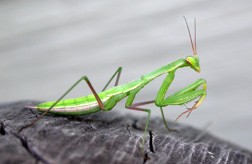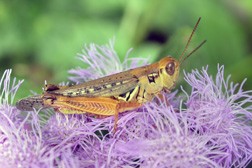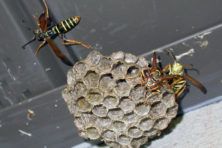Paper Wasps and Other Early Autumn Insects
- Share
- Tweet
- Pin
- Share

The hooked antennae and whitish face help identify this male Paper Wasp. Photo by Roy Lukes.
Throughout our lunch Paper Wasps, what we call Wood Wasps, flew back and forth in front of us. Later I couldn’t resist basking in the sun for a while on the Leopold bench near our front-yard flowerbeds. There I saw what appeared to be the sparring of individual wasps, which most likely was between males who are constantly on the lookout for the young, newly-emerged females, or princesses, with which to mate.
The newly mated princesses will hibernate in wood or rock piles, or under dead vegetation on the ground, while all the founding queens, workers (unmated females) and males will die. The young females will imbibe on as much high-energy nectar as they can possibly find in order to fatten up and increase their chances of surviving the winter.
When spring arrives, a queen will construct what appears to be a tiny upside-down umbrella, her single layer of beautifully constructed six-sided brood cells. Tiny bits of wood for their nests are usually gotten from weather-worn wood, old rotting fence posts or boards, or even cardboard found outdoors. The wood is chewed, partially digested and mixed with saliva, then smeared onto the nest surface where it hardens upon contact with the air. (Do you suppose these wasps were among the first paper-makers to inhabit the earth?)
Next, a single fertilized egg is laid inside each of the chambers. The eggs hatch in about two weeks, and the carnivorous larvae are fed tiny bits of caterpillars for about two more weeks until they are fully grown. A thin silky coating is produced by the queen to cover each of the openings, and within three weeks each pupa emerges as an adult female worker.
The entire first generation has been carefully raised by the queen. However, once the female workers have hatched, all having brownish faces and straight antennae, and who are capable of stinging, the queen will stop foraging and rule by dominating her offspring workers. They will carry on all the work of feeding and caring for the developing larvae, a form of classic dominance.

This gravid female Praying Mantis, ready to lay her eggs, is an amazing insect.
In case a queen dies or is lost, then the most aggressive worker takes over, begins laying eggs and continues to dominate over all below her. She has not mated and can only lay unfertilized eggs. These develop into males who have whitish faces, small hooks at the ends of their antennae, and cannot sting.
Ever since we moved to our home in the woods the wood wasps have constructed quite a few of their intricately made umbrella-like nests, usually on the underside of the soffits on our house and garden shed. Only once, when a female accidentally dropped down my wife Charlotte’s shirt collar, was she stung. One sting in nearly 30 years isn’t so bad. (Don’t tell that to Charlotte!)
Keep your distance and give your utmost respect to the White or Bald-faced Hornets that have built the gray, “paper-covered,” football-size or larger nest, perhaps in a tree on our property or up against the gable of your house. They and the Yellowjacket Hornets, which usually build their nests underground or in a woodpile, etc., are known to be easily irritated and ornery, and they appear to dislike people. Unlike Honey Bees, they can sting repeatedly. Paper Wasps, which build the small inverted umbrella-like nests, as described above, are docile and seldom sting unless molested or are unintentionally trapped, swatted at or chased.
I recall many experiences sitting in the outdoor privy on my dad’s farm apprehensively eyeing the long-legged Paper Wasps entering and leaving through the crack at the top of the door. There always seemed to be several of their small nests attached to the outhouse ceiling, but I don’t recall anyone complaining of having been stung.
The very fact that the Paper Wasps kill many potentially harmful caterpillars makes them valuable to have around vegetable and flower gardens. They are only one of thousands of life forms that enable us humans to live. They must have their niche on Earth, too, partners in nature to be respected.

A Red-legged Grasshopper, favorite creature for the caricaturist. Photo by Roy Lukes.
One fascinating insect, a large female Praying Mantis, was located and enjoyed by the members of our Bjorklunden class last week. These insects, like most others, will soon be dying, their short lives over in less than a half of a year. Their Styrofoam-like oval egg cases will survive the winter.
It wasn’t until later this summer that we finally began seeing plenty of locusts and grasshoppers. The most common by far, the Carolina Locust, is neither a true locust nor confined to only the Carolinas. It is one of the larger grasshoppers of our region and can be easily told in flight by its black hind wings that are edged in yellow. With wings closed, they are a rusty brown. They are strictly plant eaters, are surprisingly strong fliers and can easily fly 30 yards. Occasionally they hover helicopter-like as do some butterflies. This is the species we kids used to chase after, catch and squeeze to make them spit “tobacco juice.”
Today excellent pictures of insects can quite easily be gotten due to the skillfully-engineered “macro” capabilities of most digital cameras. One of my favorite insects to stalk, photograph and enjoy is the Red-legged Grasshopper. This very common and widely-distributed grasshopper in the Midwest and other states always impresses me as a very stately creature steeped in thought. This droll-faced insect has to be the perfect model for a caricaturist.
It would do all of us well to spend a portion of each day learning how to study, admire and respect some of our smaller partners in nature, including the cosmopolitan masters of spring-board dynamics, the grasshoppers.



